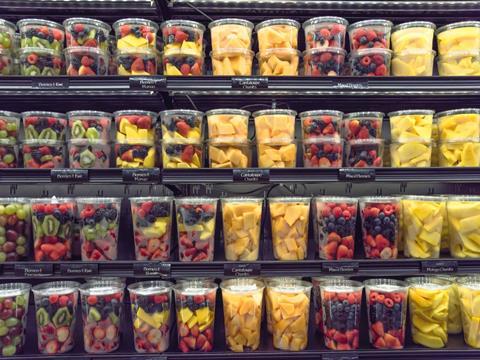
Producing edible food packaging is a sustainable solution in theory, but how do manufacturers go about testing their safety? Can edible packaging protect and preserve food products as effectively as its traditional counterparts? Paula Hirsilä, project manager and food specialist at Measurlabs, tells us more.
Food packaging is a major source of plastic waste, the effects of which can be devastating for the natural environment. This has led to calls to replace plastic packages with more sustainable options. One way to produce environmentally friendly food packages is to make them more like the food itself – edible and fully biodegradable.
Let’s briefly discuss the different types of edible food packages on the market. Firstly, products that are a “natural part of the food” like ice cream cones can be considered edible packages. A second type that often goes unnoticed is films and coatings on things like fruits, which help conserve the food but are not particularly noticeable as packaging.
Thirdly, there are more novel packaging innovations that at first seem to be plastic or paper-based but are actually edible. Examples of these include edible “plastic” pouches, like the ones produced by Notpla, or wrappers like Gousto’s stock cube wraps.
What are novel edible food packages made of?
Edible food packages can be produced from various substances. Some examples include polysaccharides like starch and proteins like gelatin, gluten, and pea protein.
Several different components are usually required to make the material function as a packaging material. The development process of edible plastic-like packages tends to be difficult and time-consuming, as it is challenging to replicate the functionalities of plastic using biodegradable materials.
The added requirements of ensuring that the material is safe and pleasant to consume further increase the challenge of creating edible food packages.
Ensuring the safety of edible packages
While traditional food packages need to be tested to ensure that they do not transfer harmful substances to the food, edible packages must be similarly tested to ensure that they are safe to consume.
One key aspect of assessing the safety of edible food packages is microbiological testing, where the packaging is tested for harmful micro-organisms like E. coli and Salmonella.
Edible packages also need to go through allergen testing, where possible allergens like gluten or lactose are identified.
In addition, a nutritional analysis should be performed to identify the nutritional content of the material.
One of the biggest challenges in producing edible food packaging is to avoid contamination throughout the life cycle of the product. Contamination may occur during the production process, transportation, storage, or end-use of a product. The last two are of particular concern in the case of edible food packages, as it may not be safe to consume the packaging if it has been in contact with store shelves or dirty hands.
The contamination issue may be circumvented by only replacing the individual packages of items like stock cubes or ice cream with edible ones while storing them in one larger package of disposable material. The disposable material should be sustainable, however, as otherwise the environmental benefit of using edible packaging is not fully realised.
Edible packages and food conservation
In addition to making sure the packaging material is safe to eat, edible food packages must also be tested for their capabilities to conserve the food they contain. This is especially important in the case of sealed, supposedly airtight packages meant to replace plastic alternatives in increasing the shelf-life of a product.
The conservation properties of edible packaging materials can be tested with oxygen transmission rate (OTR) and water vapor transmission rate (WVTR) analyses, which are also used with more traditional food packaging materials. The OTR measures the rate at which oxygen passes through the material, while the WVTR measures the same for moisture. Together these analyses help to ascertain the conditions in which edible food packages stay intact and protect food from the detrimental effects of exposure to oxygen and moisture.
In addition to OTR and WVTR testing, surface morphology, cross-sectional structure, and thickness of packaging films can be evaluated using imaging techniques such as scanning electron microscopy (SEM) and transmission electron microscopy (TEM). These methods might reveal, for example, if a film contains holes, scratches, or other abnormal structures that could possibly lead to quick deterioration of the food stored inside the film.
Finally, the functional properties of edible films will be confirmed with shelf-life testing to ensure that the organoleptic and microbiological qualities of the food product are maintained for as long as intended.
The future of edible packaging
While the sustainability advantages of edible food packaging are considerable, the challenge of developing materials that are safe, pleasant to eat, and comparable to plastics in their ability to conserve food is also significant. Often the development process takes years and many trials and errors, which makes it difficult to sustain from a business perspective.
Despite these challenges, edible food packages are likely to become more mainstream in the future as the environmental consciousness of consumers increases.











No comments yet